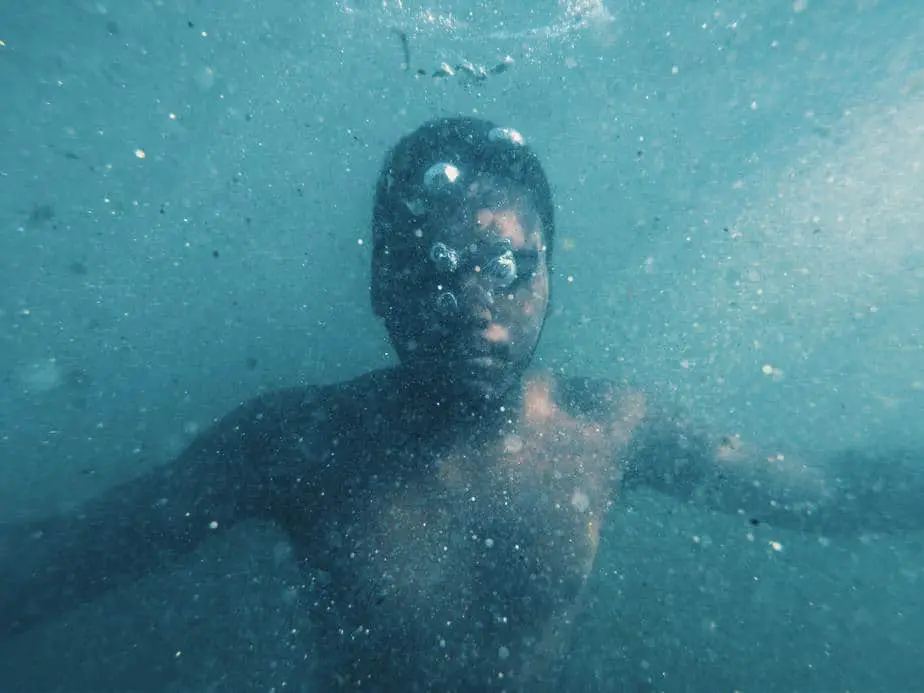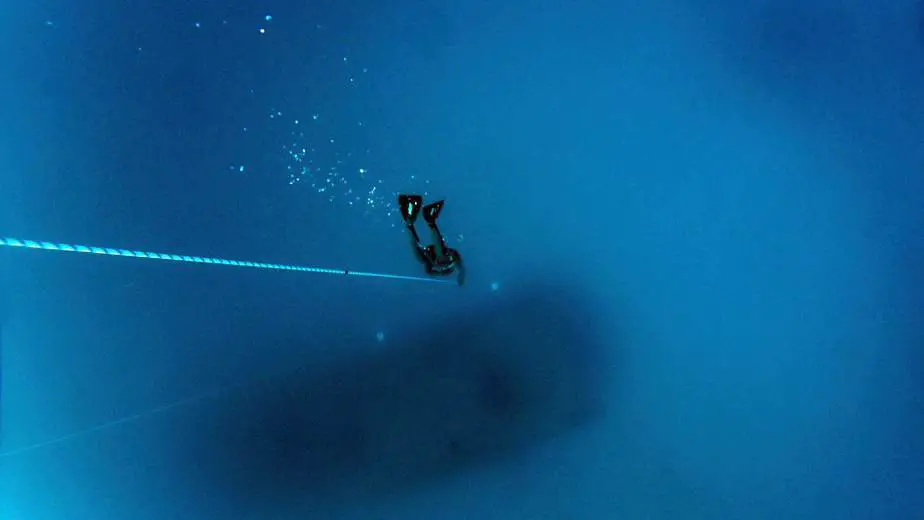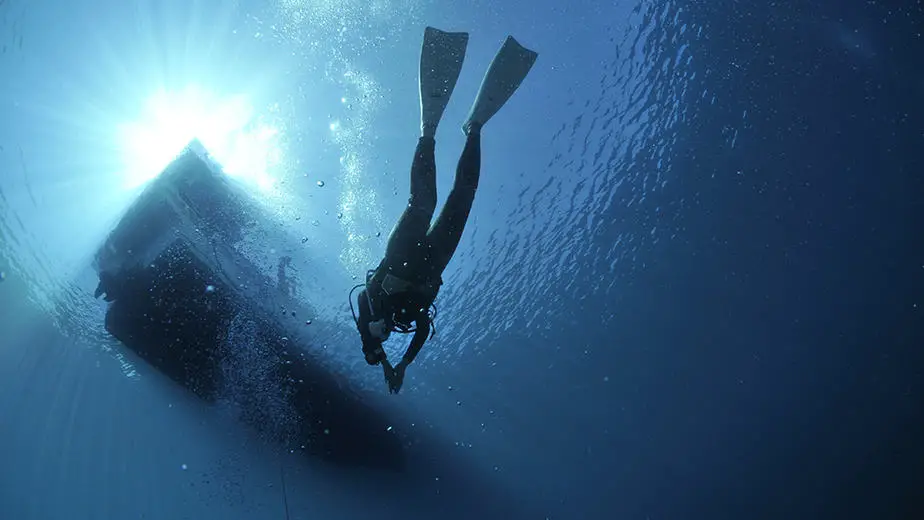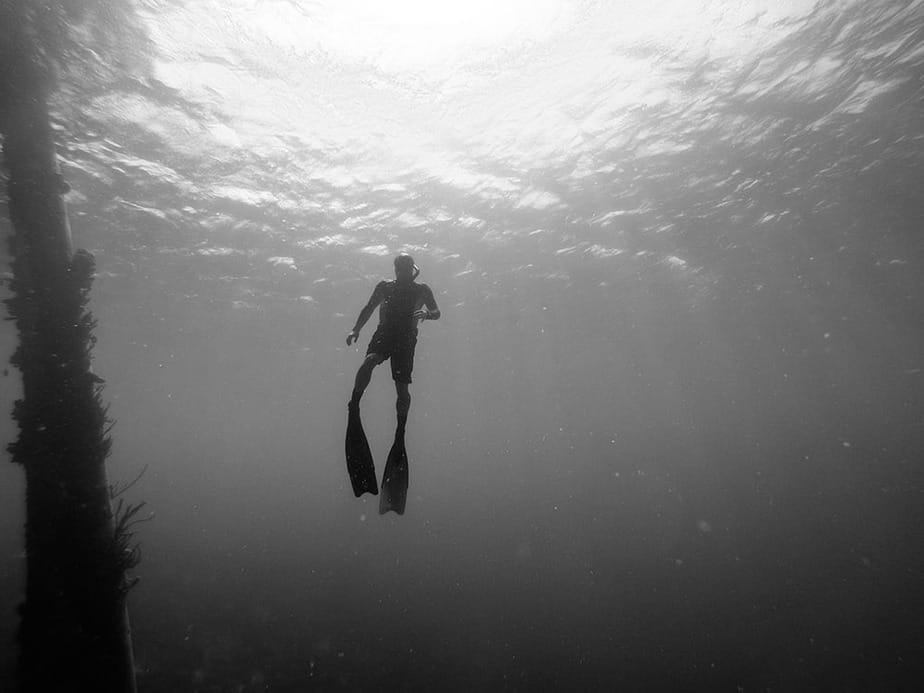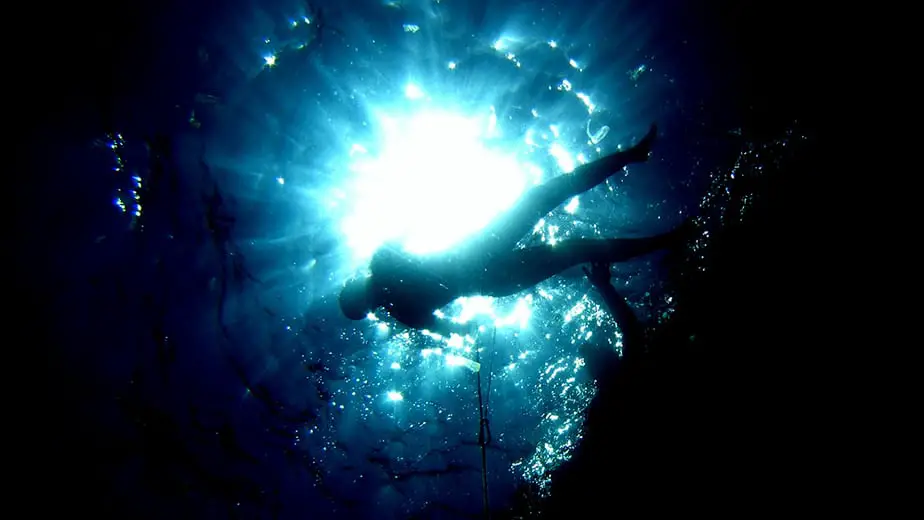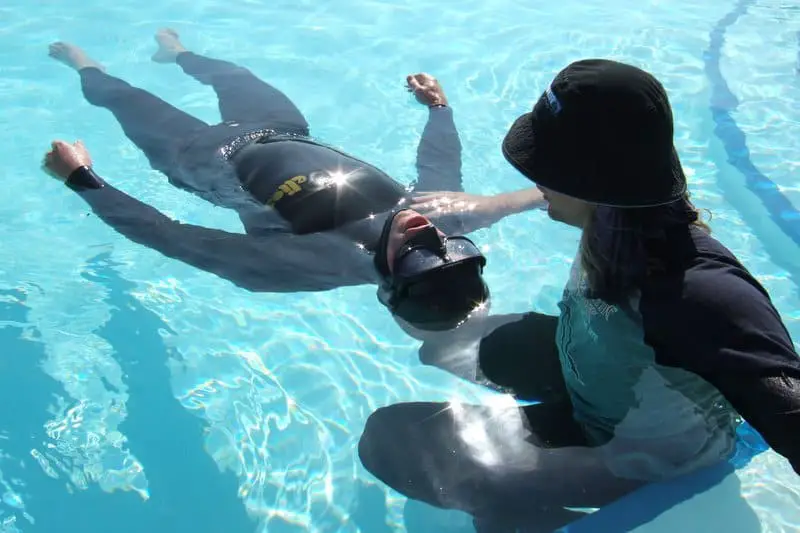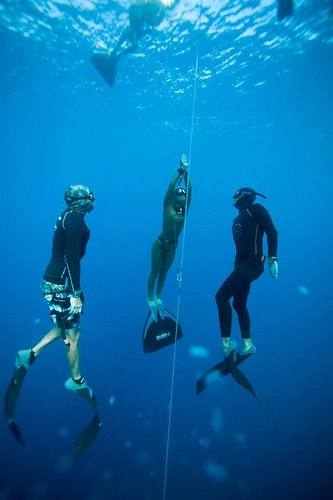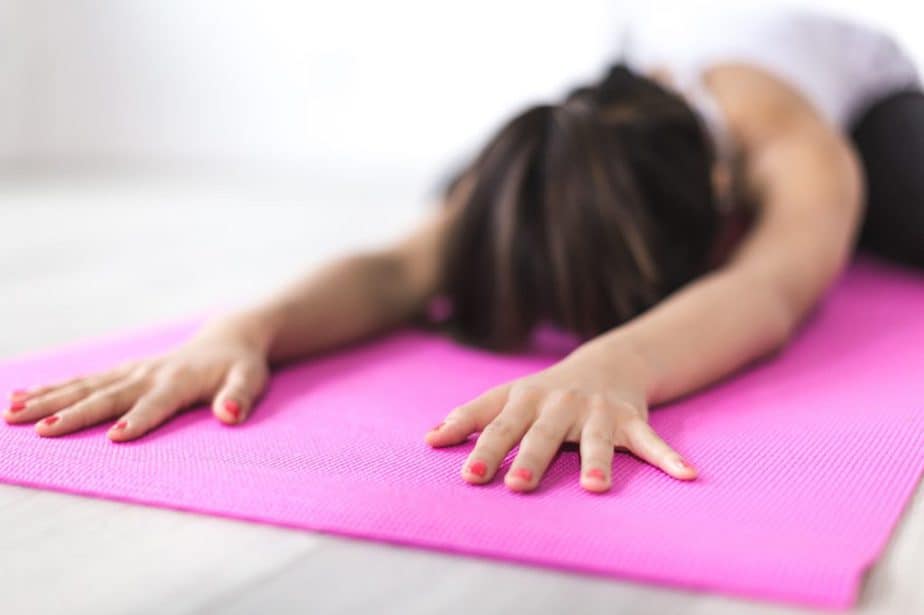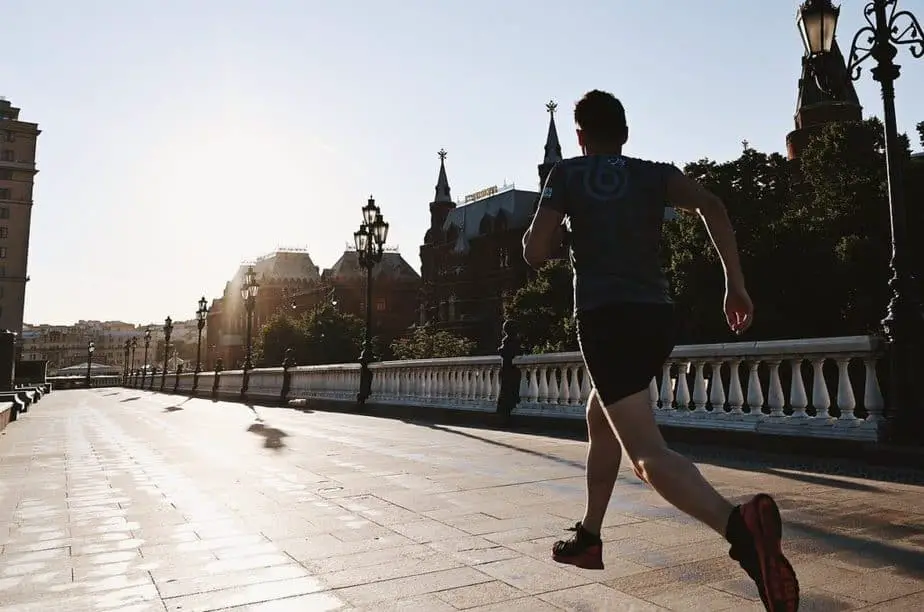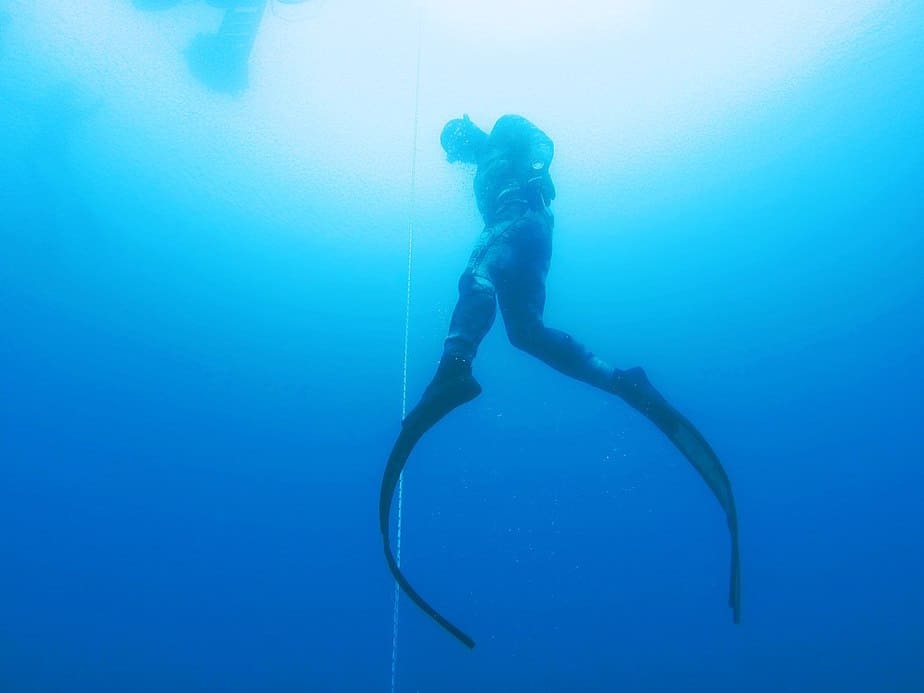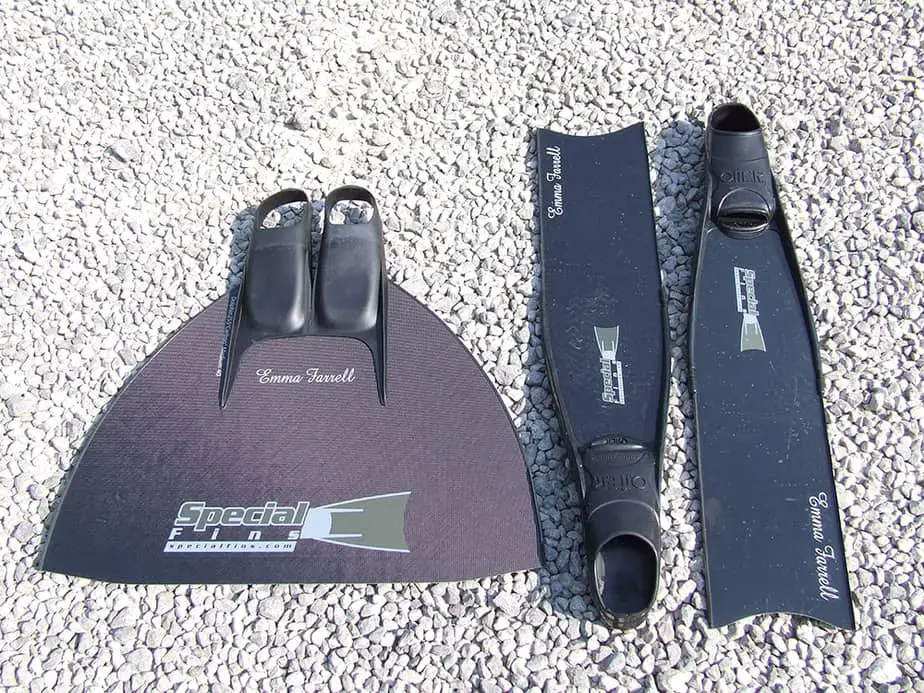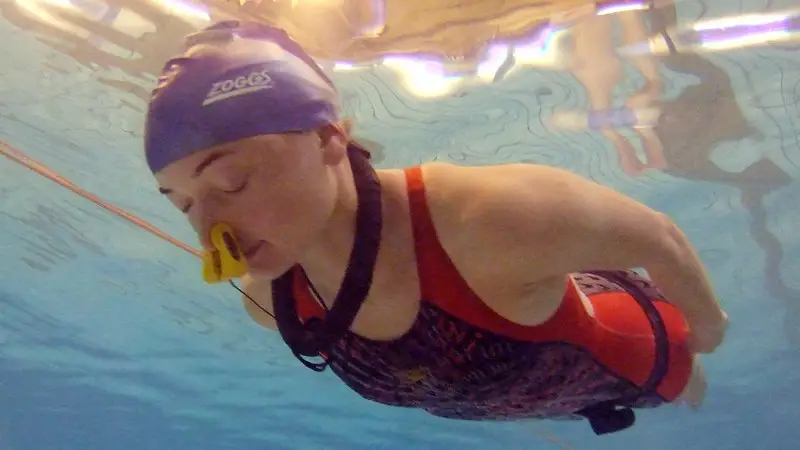Lung packing is a technique that some freedivers use to inhale more air than their lungs can normally hold. The purpose of lung packing is to literally pack more air into your lungs in the hopes that your body will benefit from the additional oxygen when diving.
The general idea behind lung packing is to first take a full natural breath, then start a secondary inhalation period where you suck more air with your mouth. With a special technique, you can force the extra air into the lungs with a movement similar to swallowing. This results in your lungs being overinflated past their natural total capacity.
Lung packing is an old-school freediving technique that was created and utilized during a time when freedivers thought that more air in the lungs is always better. Packing has since become quite controversial among freedivers due to the risks involved as well as questionable efficacy.
There is also a question of whether lung packing is even needed, since many freedivers do not use it and they can still manage to reach depths of 100m or stay underwater for over eight minutes during static apnea.
In this guide, we will do a in-depth look at what lung packing is, how to do it, the supposed benefits it provides, and the arguments against lung packing regarding how potentially dangerous it can be.
What Is Lung Packing?
Lung packing can also be referred to as air packing, frog breathing, carpa, buccal pumping, or glossopharyngeal inhalation.
Outside of freediving, lung packing is sometimes used by individuals who have low lung volume and weakened breathing muscles. It can also be used by those affected by muscular dystrophy, spinal injuries, and polio.
Glossopharyngeal inhalation can let people who have lung problems breathe in the event that their breathing apparatus somehow fails unexpectedly. This breathing technique has saved the lives of many people by forcing oxygen into their lungs. Through the use of their tongue, cheeks, and pressure differences, it is possible to swallow air into one’s lungs without inhaling.
Lung Packing for Freediving
Freedivers train their lungs to hold more oxygen, and lung packing is a sort of “hack” that forces their lungs to hold oxygen over its capacity. The theory is that the more oxygen in the lungs, the longer and deeper the dives.
When the average person breathes, their lungs will fill up with around four to six liters (1.05 to 1.58 gallons) of air. With lung packing, one can go over that capacity by 10 to 50%, depending on how good you are with the technique.
Without lung packing, the only other ways to increase oxygen levels is to train with an Air Restriction Device which helps train lung volume, or to use a low-volume dive mask to conserve oxygen when equalizing pressure.
Getting a significant increase in oxygen levels is a very attractive option for most freedivers, so it’s no surprise that many have tried to learn how to do it.
How to Lung Pack
Note: We are not doctors and lung packing has its share of risks (discussed further below). If you plan on doing any lung packing, you do so at your own risk and we strongly recommend you see a doctor first.
Furthermore, if you use a weight belt, make sure that it is not made out of nylon or a similar inelastic material. Nylon will restrict your diaphragm, preventing you from fully inhaling and limiting your breathe-up. You should look into getting a rubber weight belt that will stretch as you inhale and move your body.
Without further ado, here is how to lung pack.
Step 1: Calm your breathing and heart rate.
Take 3-5 deep, slow breaths, then resume breathing at your normal rate. Next, imagine a pleasant scene that puts you at ease, such as the relaxing sound of rain outside as you drink hot coffee at your favorite café, or the splashing of waves against the side of the boat on a beautiful sunny day. Or you could just close your eyes and focus on your breathing, much like meditation.
Step 2: Fully inhale
Next, you will fill your lung to its natural capacity by breathing in deeply and slowly. Start by filling your stomach, then after a brief pause, continue inhaling into your chest until it expands to its limit.
Step 3: Close your throat
There are two things you need to do in order to seal your throat. First is to close your glottis (the opening between your vocal cords). Second is to seal the back roof of your mouth. This is an important step, so you may want to practice this before moving on.
Step 4: Create a vacuum in your mouth
You can create negative pressure in your mouth by opening your mouth slightly while your throat is still sealed. Lower your jaw and press your tongue to the back of your mouth to create the vacuum effect.
Step 5: Gulp air into your lungs
Now close your lips and swallow the trapped air into your lungs. If you’ve never lung packed before, start small. Try to manage 3-5 gulps if you can, or listen to how your body feels and if you think you can fit more then do it.
Step 6: Exhale
Finally, let all of the air out of your lungs. We recommend you practice lung packing on land just in case anything goes wrong. If you are in the water, you will need an instructor or safety diver to look over you in case you lose consciousness from holding your breath.
Hire an instructor
As with any technique, it can be tough starting out without the proper guidance. You could be doing it completely wrong and not even know. Admittedly, following written instructions isn’t the greatest way to learn either. So we recommend you hire a mentor to give you personal, one-on-one guidance.
Another option is to watch an instructional video. Here is a great video that teaches beginner freedivers how to lung pack. We recommend you watch the entire video because of how informative it is.
Lung Packing Breathing Techniques
The way lung packing is done is nearly identical across all freedivers. After all, the idea is to stuff more air into your lungs beyond what it can normally hold by utilizing negative pressure differences. As you can imagine by that description, stretching your lungs beyond capacity will feel uncomfortable and it comes with risks which we will discuss further below.
There may be some slight differences between lung packing breathing methods, however the differences are so minor as to be nearly negligible. For instance, one guide may recommend using your cheeks to create negative pressure instead of your tongue. One is not necessarily better than the other as long as you can create the negative pressure.
In the end, you should do the lung packing approach that you feel is most reliable for you to do. If you want to try out the different variations of lung packing, we recommend you hire an instructor or join a freediving group that is willing to educate a beginner.
Who Should Lung Pack?
Lung packing is a technique that should be used only by advanced freedivers. As a beginner, you can learn about the general principles and decide later on if you want to pursue it some more. However, your primary focus should be on being a better breather in general instead of focusing on lung packing.
If you don’t know the basics, then lung packing may do more harm than good. You should first be proficient in your breath-hold training, as well as learning how to calm yourself down and entering the Flow state.
Lastly, getting some practical freediving experience by heading into the water a few times a week will teach you more about the practical aspects of freediving more than any video or article can teach you. Learning about theory is good, but it must be combined with a hands-on approach.
After you have become proficient at breath-hold training, learning how to stay calm and keeping your heart rate low, you can then move on to lung packing. As a matter of fact, any beginner and even intermediate freedivers can potentially damage their lungs if they are not careful, and even AIDA doesn’t recommend lung packing.
Potential Benefits of Lung Packing
If you have more air in your lungs due to lung packing, then doesn’t that mean you can dive for longer? That’s what some freedivers would say it does. Besides this, lung packing may also:
- Increase lung capacity which makes it easier to equalize pressure at depth.
- Relaxes your airway.
- Increase overall performance by giving you more oxygen to work with.
How Effective is Lung Packing?
Many of the supposed benefits of lung packing come from personal anecdotes and may not be scientifically sound. For instance, there is a study that came to the conclusion that lung packing can potentially reduce freediving performance.
Ironically, by forcing more oxygen into your lungs, you can end up lowering your stroke volume and decreasing cardiac output. To address this problem, the body releases adrenaline which increases your heart rate and keeps you from fainting. However, an increased heart rate will use up your oxygen stores faster, which defeats the purpose of lung packing since you may end up decreasing your overall dive time.
Furthermore, lung packing takes time to do. The time you spend by the surface holding your breath as you try to gulp more air is time you could have spent diving deeper underwater. Additionally, lung packing is uncomfortable and increases your heart rate which means you will not be as calm as you ought to be.
Lastly, an increased amount of oxygen means you are more positively buoyant for the initial portion of your dive. You will need to exert more force to break through this point, which uses up more oxygen than normal.
Potential Injuries from Improper Lung Packing
In addition to its questionable efficacy, lung packing can also lead to serious injuries if done properly. Below is a list of some potential issues, some more severe than others, when one over-packs their lungs during long breath-hold dives.
- Decompression sickness, the side effects include confusion, paralysis, and dull aches in joints.
- Nitrogen narcosis which can cause dizziness, loss of touch, and hallucinations.
- Lung squeeze which results in chest pain, coughing up blood, and fluid in lungs.
- Pneumothorax or collapsed lung, which leads to shortness of breath and chest pain.
- Injury to the heart muscles.
- Ceased heart function.
- Gas embolisms.
There are many more potential injuries one can sustain, however these are the most common ones. The last few bullet points are incredibly dangerous and can lead to death. As such, lung packing is not something to take lightly; if done wrong, you can die.
Gas Embolisms from Lung Packing
What are gas embolisms? They are a potential side effect of forcing too much air into your lungs.
When you pack too much air into your lungs, the air pressure within gets elevated to such intense levels that your lungs cannot withstand the volume held in them. The air will try to move to any area that has more space available.
Unlike balloons which simply explode when they’ve been overinflated, our lungs are thankfully more resilient. However, the air pressure can cause air bubbles to escape by squeezing through the linings of your lungs.
The air bubble can then enter straight into your bloodstream. This gas embolism will travel through your body and block blood vessels and arteries, which is incredibly life-threatening. It can result in strokes, loss of consciousness, convulsions, and death.
Blackouts from Lung Packing
Shallow water blackout and above-the-water blackouts are some of the dangerous risks associated with going too far with lung packing. Results from this study have found that it increases intrathoracic pressure which can lead to dizziness or even blacking out just prior to the dive attempt.
The reason this happens is because the intrathoracic pressure causes your heart’s cardiac output to decrease, lowering overall blood pressure. Once your blood pressure drops to a certain point, the brain becomes starved for oxygen and shuts down to conserve oxygen, causing a blackout.
Once you blackout, your body will start inhaling while you are unconscious to try to get oxygen into your system. On dry land this is not an issue, as this natural reaction could save your life. However, if you blackout while underwater, the inhalation which would normally fill your lungs with air will instead fill them with water, and you will drown.
Freedivers already have a chance of blacking out without lung packing, and if you end up over-packing your lungs you can further increase the chances of a blackout both under or above the water.
Lung Packing While on Dry Land
While blacking out isn’t as dangerous on dry land, that’s not to say that there isn’t any risk involved. If you are practicing lung packing, make sure you are in a space environment, such as on your bed or on a padded mat. This is to protect your head in case you do blackout.
If your head hits something with enough force, the impact could be lethal. To minimize the damage, try practicing lung packing while seated or lying on the floor. That way, suddenly fainting won’t hurt your head, and your brain will automatically force your body to breathe again.
With that said, lung packing on dry land can still be lethal, since forcing too much air into your lungs is dangerous. You can still suffer all of the same injuries as someone lung packing in the water, such as lung squeeze, pneumothorax, gas embolisms, and so on. That is why you should go at your own pace and not to rush things.
Is Lung Packing Necessary for Deep Dives?
No, there are numerous top freedivers that set world records without lung packing. In fact, most freediving world records were done without lung packing. As such, don’t feel compelled to learn lung packing because clearly it isn’t an absolute must to know.
Some beginner freedivers hear that some advanced freedivers used it to great success, or want to copy what they see in a YouTube video, but these same freedivers are in danger of imitating the wrong technique.
After all, lung packing is an advanced technique, and beginners may be trying to learn something beyond their current understanding of breathing techniques and jeopardizing their safety in doing so.
One should be patient and take the time to properly learn the basics. Do not be eager to advance too quickly, but instead, get a strong grasp of the fundamentals and refine these techniques over time. Staying safe should be a freediver’s top priority.
However, freediving is an inherently dangerous sport that attracts risk takers, so perhaps you have already weighed the risks of lung packing and deemed it a risk worth taking. Personally, we feel that for every supposed benefit lung packing provides, it has a disadvantage that negates it.
Yet if you must learn lung packing at all costs, try to find a professional freediver in real life (not online, not from a YouTube video) and have this person do a one-on-one training session with you. If the instructor is any good, he should start off slow but ramp up the difficulty over time. Impatience will only increase the chances of accidents.
Reverse Lung Packing
You’ve heard a lot about lung packing, but there is another breathing technique known as reverse lung packing which you may be interested in.
Reverse lung packing is a training technique performed on dry land which mimics the strain that the underwater pressure places on one’s body and lungs. It can help train your lungs to be more resistant to injuries that can be sustained when subjected to intense pressure underwater.
Furthermore, reverse packing can increase diaphragm flexibility similar to an air restriction device. This can allow you to equalize more effectively and dive deeper. Unlike lung packing, most freedivers agree that reverse lung packing is safe and is recommended for a freediver who wants to reach their full potential.
How Reverse Lung Packing Works
Reverse lung packing works by decreasing the residual volume in your lungs. The residual volume is the reserve of air left in your lungs after you fully exhale, and it is the reason why you don’t immediately pass out afterwards.
Since you normally can’t exhale the residual volume, reverse lung packing is needed. Similar to lung packing, reverse lung packing utilizes negative air pressure to funnel out the residual volume out of your lungs. Doing this will cause the lung tissue as well as other tissues in the chest cavity to stretch, which can help improve your lung volume.
How to Perform Reverse Lung Packing
Step 1: Lie or sit down somewhere
As with any breathing exercise, there is always a risk of blacking out. As such, you should practice your breathing techniques in a safe, padded environment preferably while sitting or lying down. That way, in the event that you blackout, you will not hit your head hard. Do not practice reverse lung packing while standing.
Step 2: Steady your breathing
Start by breathing normally so that your heart rate is low and your mind is calm. At this point, don’t bother counting breaths, or trying to breath in perfect intervals, or hyperventilating. Just breathe calmly.
Step 3: Take a deep breath
Once you feel ready, take a long, deep breath through your mouth until both your lungs and stomach fills up completely.
Step 4: Fully exhale
Now, slowly exhale all of the air starting from your chest, then your stomach. Once you feel like you are out of breath (you actually aren’t), start tensing the muscles above your stomach to squeeze even more air out.
To get even more air out, tilt your head back slightly and keep squeezing your diaphragm muscles to get some more air out.
Step 5: Create negative pressure
Untense all of the muscles that you are currently using to exhale. Seal your nose and lips tightly. If you were wearing a nose clip this whole time, then just focus on sealing your lips. With both nose and lips sealed but throat open, lower your jaw and tongue. This should siphon the remaining air from your lungs into your mouth.
Step 6: Exhale remaining air
Seal your glottis. Move your jaw and tongue back to their original position. Push the air out of your mouth by applying tension to your cheek muscles.
Step 7: Perform reverse gulps
Keep repeating the step above, pumping the air out of your lungs like pistons. This is like the opposite of lung packing, where you are trying to gulp in more air. Here, you are trying to remove as much air from your lungs as possible, hence “reverse gulp”.
Once enough air has been expelled, you will reach a point where there is only the residual air volume remaining. You will know that you’ve reached this point once you feel lightheaded, your collar bones are visibly prominent, and your diaphragm is squeezed so tightly that you look very thin.
Step 8: Inhale
Relax all of your muscles and breathe in slowly. Reset your heart rate and give your body time to rest by spending a few minutes breathing in and out slowly.
Congratulations, you’ve just read about how to do reverse lung packing. This technique is hard to describe in words, so we recommend you check out this video to supplement your learning.
Benefits of Reverse Lung Packing
- Strengthens muscles around the ribcage and improves diaphragm flexibility.
- Conditions your lungs to dive deeper for longer.
- Strengthens your lungs to become resistant against injuries at deep depths.
- Helps with equalization at deep depths.
- Acclimates your lungs to intense pressure by simulating its effects but on dry land.
Who Should Do Reverse Lung Packing?
Any freediver can benefit from practicing reverse lung packing. It is something you can do on dry land and is a great tool to help you get used to deep diving. However, learning how to do reverse lung packing correctly is difficult without an instructor, so beginners would benefit the most from getting some help from an experienced freediver first. Doing something wrong can ingrain bad habits, but when it comes to breathing techniques, special attention must be given.
Is Reverse Lung Packing Safe?
We’ve already mentioned how normal lung packing has its fair share of risks, and should only be attempted by the most experienced of divers. Thankfully, reverse lung packing is less dangerous, but obviously care must still be taken when interfering with your breathing.
The main reason why reverse lung packing is safer is because you are expelling the air from your lungs which is not as strenuous on your body as over-inhaling is. With that said, there are still a few potential risks you should be wary of, such as:
Blackouts
All freediving breathing techniques have a risk of causing you to blackout from lack of oxygen. If you blackout on dry land while standing, you can easily land head first and cause serious injury to yourself. Set up a padded environment by placing pillows around you or lying down on a soft mat so that in the event you do blackout, you will land on a soft surface.
If you decide to practice reverse lung packing in the water, then blacking out becomes significantly more dangerous. As we explained earlier, your brain will tell your body to start breathing again while unconscious, which means you will inhale water instead of air and drown.
Lung Squeeze
Once again, if you practice reverse lung packing while underwater, then the negative pressure difference could cause a lung squeeze. Though this is not likely to occur and the injury is not considered to be serious, it’s still something to keep in mind. If a breathing technique can be practiced on dry land, such as this one, then we recommend it just to be safe.
Should You Lung Pack: The Verdict
Due to the potential risks associated with lung packing, and in addition to the fact that AIDA do not recommend it, we also cannot in good conscience recommend this breathing technique even if it has been successfully used by some freedivers. Another fact is that many of the current top freedivers do not use this technique, so clearly it’s not something that is a necessity to employ in competition.
On the other hand, reverse lung packing is something that can be done relatively safely and its benefits are desirable. At the end of the day, it’s up to you to weigh the risks and if you feel like lung packing is absolutely crucial for you to know in order to reach your goals, then nobody is stopping you. Just take things slowly and ease your way to new limits.
Alternative Breathe-Ups instead Lung Packing
So if lung packing isn’t recommended, then what should you do instead? The answer is that there is no right or wrong way for breathing up before a dive. The ideal breathe-up is literally just normally breathing and relaxing yourself so that your heart rate is low and your mind is calm.
Doing this slow, almost meditative breathing is way more straightforward than memorizing some inane instruction like “breathe in for exactly X seconds, then exhale for Y seconds.” Advice like this can paralyze beginners who follow the instructions to the letter, but then get stressed out when they slightly mess it up. Stressing out defeats the entire purpose of the breathe-up!
That is why we recommend keeping things simple, and slowly breathing in and out is sufficient to ready your mind and decrease your heart rate before a big dive. Once you can do this basic thing, then you can consider moving on to more advanced breathing techniques like lung packing.

